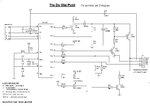GuiRitter
Junior Member level 1
Hi everyone.
I want a PIC programmer, but I live in a city with limited options regarding electronics, specially microcontrollers. Building one will be much cheaper than buying one, and I should have built one when I made my mechatronics technician's course, but didn't because I didn't liked the design, so I want to do it now.
After a lot of search I settled in **broken link removed** design. I guess it's as simple as it could get. I only want it to program the most common models, nothing more.
But there are some things in that link that I'd like to understand more clearly before ordering the remaining parts:
1. As I understood, the MCLR, GND, PGD and PCG of J1 are connected to the same-named pins of the target PIC, and nothing else. No need to power it separately. Am I right?
2. I can't obtain some of the components, so I'd like to know if I can make the following switches:
C1 and C2 to 22 pF or 27 pF;
C4 to 33 µF;
C5 to 2,2 µF.
3. What is D2 supposed to be? I know it's a diode, but there's no model.
4. Does the "FLAT" on the transistors' names mean something important?
I think the rest will be easy. Until I get to turn it on and test it...
Thanks in advance.
I want a PIC programmer, but I live in a city with limited options regarding electronics, specially microcontrollers. Building one will be much cheaper than buying one, and I should have built one when I made my mechatronics technician's course, but didn't because I didn't liked the design, so I want to do it now.
After a lot of search I settled in **broken link removed** design. I guess it's as simple as it could get. I only want it to program the most common models, nothing more.
But there are some things in that link that I'd like to understand more clearly before ordering the remaining parts:
1. As I understood, the MCLR, GND, PGD and PCG of J1 are connected to the same-named pins of the target PIC, and nothing else. No need to power it separately. Am I right?
2. I can't obtain some of the components, so I'd like to know if I can make the following switches:
C1 and C2 to 22 pF or 27 pF;
C4 to 33 µF;
C5 to 2,2 µF.
3. What is D2 supposed to be? I know it's a diode, but there's no model.
4. Does the "FLAT" on the transistors' names mean something important?
I think the rest will be easy. Until I get to turn it on and test it...
Thanks in advance.
